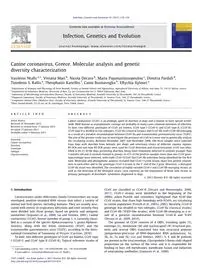
2013 Canine coronavirus, Greece_ Molecular analysis and genetic diversity characterization PDF
Preview 2013 Canine coronavirus, Greece_ Molecular analysis and genetic diversity characterization
Canine coronavirus, Greece. Molecular analysis and genetic diversity characterization Vasileios Ntafis a,⇑, Viviana Mari b, Nicola Decaro b, Maria Papanastassopoulou c, Dimitra Pardali d, Timoleon S. Rallis e, Theophanis Kanellos f, Canio Buonavoglia b, Eftychia Xylouri a a Department of Anatomy and Physiology of Farm Animals, Faculty of Animal Science and Aquaculture, Agricultural University of Athens, Iera Odos 75, 118 55 Athens, Greece b Department of Veterinary Medicine, University of Bari, S.p. per Casamassima km 3, 70010 Valenzano, Bari, Italy c Laboratory of Microbiology and Infectious Diseases, Faculty of Veterinary Medicine, Aristotle University of Thessaloniki, 541 24 Thessaloniki, Greece d Diagnostic Laboratory, Faculty of Veterinary Medicine, Aristotle University of Thessaloniki, St. Voutira 11str., 546 27 Thessaloniki, Greece e Companion Animal Clinic (Medicine Unit), Faculty of Veterinary Medicine, Aristotle University of Thessaloniki, St. Voutira 11str., 546 27 Thessaloniki, Greece f Pfizer Animal Health, 23–25 ave du Dr Lannelogue, Paris 75668, France a r t i c l e i n f o Article history: Received 26 November 2012 Received in revised form 17 January 2013 Accepted 27 January 2013 Available online 8 February 2013 Keywords: Canine coronavirus Diarrhea Genotype Subtype Characterization a b s t r a c t Canine coronavirus (CCoV) is an etiologic agent of diarrhea in dogs and is known to have spread world- wide. Mild disease or asymptomatic carriage are probably in many cases common outcomes of infection. To date, two different genotypes of CCoV are known, CCoV type I (CCoV-I) and CCoV type II (CCoV-II). CCoV type II is divided in two subtypes, CCoV-IIa (classical strains) and CCoV-IIb, with CCoV-IIb emerging as a result of a putative recombination between CCoV-IIa and transmissible gastroenteritis virus (TGEV). The aim of the present study was to investigate the presence of CCoV in Greece and to genetically analyze the circulating strains. Between December 2007 and December 2009, 206 fecal samples were collected from dogs with diarrhea from kennels, pet shops and veterinary clinics of different country regions. RT-PCR and real time RT-PCR assays were used for CCoV detection and characterization. CCoV was iden- tified in 65.1% of the dogs presenting diarrhea, being more frequently detected in animals younger than 3 months old and in animals housed in groups. In 47% of the positive samples more than one CCoV geno- type/subtype were detected, with triple CCoV-I/CCoV-IIa/CCoV-IIb infections being identified for the first time. Molecular and phylogenetic analysis revealed that CCoV-I Greek strains share low genetic related- ness to each other and to the prototype CCoV-I strains in the 5’ end of the S gene. Moreover, a divergent CCoV-IIa strain was identified. The circulation of highly variable CCoV-I and CCoV-IIb emerging strains, as well as the detection of the divergent strain, raise concerns on the importance of these new strains as primary pathogens of diarrhoeic syndromes diagnosed in dogs. � 2013 Elsevier B.V. All rights reserved. 1. Introduction Coronaviruses (order Nidovirales, family Coronaviridae) are large enveloped, positive-stranded RNA viruses that infect a variety of animal and bird species, including humans. They are usually asso- ciated with enteric or respiratory infections and until recently they were divided into three groups, based on genetic and antigenic similarities (Enjuanes et al., 2000; Lai and Holmes, 2001). Canine coronavirus (CCoV), former member of group 1, is currently classi- fied as a variant of the species Alphacoronavirus 1, genus Alphacor- onavirus, along with the feline coronavirus (FCoV) and the transmissible gastroenteritis virus (TGEV), according to the Inter- national Committee of Taxonomy of Viruses (Carstens, 2010). To date, two different genotypes of CCoV are known, CCoV type I (CCoV-I) and CCoV type II (CCoV-II). Typical reference strains of CCoV are classified as CCoV-II (Decaro and Buonavoglia, 2008, 2011). CCoV-I strains were identified in the beginning of the 2000s, when Pratelli and coworkers highlighted that FCoV-like CCoV strains, that share high homology with FCoVs, are circulating in canine population (Pratelli et al., 2001a, 2002). Recently, CCoV-II genotype was divided in two subtypes, CCoV-IIa (classical strains) and CCoV-IIb (TGEV-like strains), with CCoV-IIb emerging as a re- sult of a putative recombination between CCoV-II and TGEV (Decaro et al., 2009, 2010). The genome of CCoV consists of 4 ORFs, encoding spike (S), envelope (E), membrane (M) and nucleocapsid (N) structural pro- teins and several ORFs translated into non structural proteins (polyprotein-precursor of RNA-dependent RNA polymerase, 3a, 3b, 3c, 7a and 7b) (Lai and Holmes, 2001). S, E and M proteins are present in the viral envelope. Glycoprotein S forms club-shaped projections on the surface of the virus and it is responsible for binding to host cell membranes, membrane fusion and induction of neutralizing antibodies (Enjuanes et al., 2000). 1567-1348/$ - see front matter � 2013 Elsevier B.V. All rights reserved. http://dx.doi.org/10.1016/j.meegid.2013.01.014 ⇑ Corresponding author. Tel.: +30 2105294399; fax: +30 2105294388. E-mail address:
